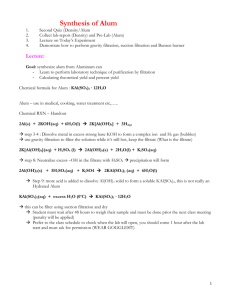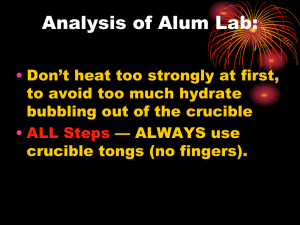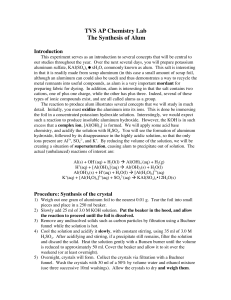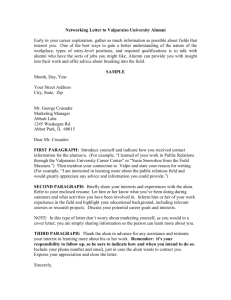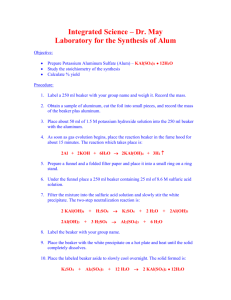Weighing 1” x 2” Al foil
advertisement
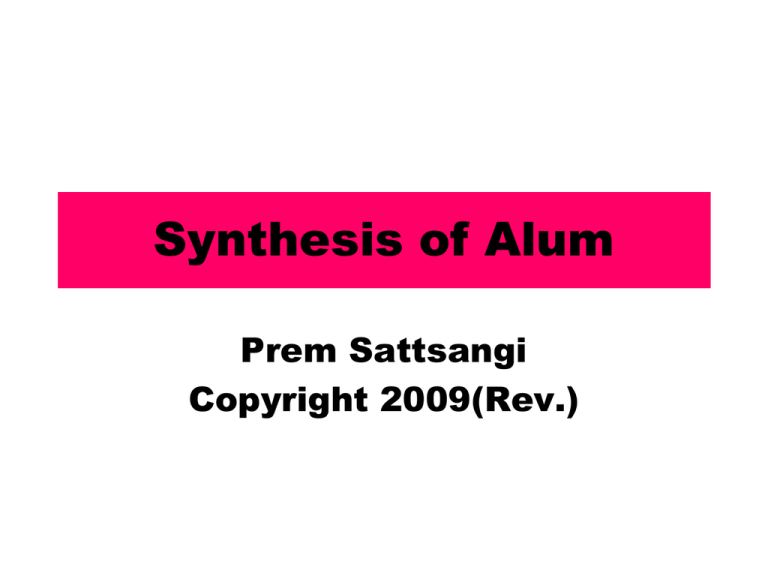
Synthesis of Alum Prem Sattsangi Copyright 2009(Rev.) #2 Synthesis of Alum Al KAl(SO4)2.12H2O K2SO4 + Al2(SO4)3 2 Simple salts 2KAl(SO4)2.12H2O A Complex Salt FW = 474g/mol Theoretical Yield: (BLB, p. 102) Al (FW = 27.0) 1mol Al produces 1mol KAl(SO4)2.12H2O • Limiting reagent (BLB, p. 100) • • • Calculate Theo. yield of Alum (g) from 0.2345 g Al. [Hint: Al(g) Al (mol) Alum (mol) Alum(g)] #3 Analytical Balance Tare, place foil, close door, record wt. Calculate Theoretical Yield Of Alum from 0.0566 g Al #4 Cut Al foil in 16 squares • Length wise • Breadth wise #5 Plastic Reaction vial with cut Aluminum foil #6 Mark MP Bulb 1, 2, 3, cm a. b. Fill Micropipet with 1.5 M KOH to 2 cm mark c. Add to reaction vial #7 Add more KOH (1cm) a. Fill KOH to 1 cm mark b. Add to reaction vial #8 Start reaction, In fume hood, Label 250 mL beaker with Stn. # (a) Take hot tap water up to 2cm mark in the coffee cup. (b) Support the coffee cup in 250 mL beaker (Stn.#__) STN# 4 (c) FLOAT reaction vial in the coffee cup using forceps. #9 Oxidation Numbers HELP KEEP TRACK OF ELECTRONS •BLB p. 128-129 •Ox.No. of elements in standard states = 0 •Ox.No. of an ION = Charge on it Ox.No. • • • • • • Aluminum (foil) Aluminum ion (Al3+) Hydrogen (H2(g) Hydrogen ion (H+) Hydride ion (H:-) H in water [H+ OH-] LEO the lion says GER Al foil 0 +3 Loss of Electron = Oxidation 0 +1 -1 Gain of electron = Reduction +1 #10 Allow REDOX reaction to finish ELECTRONS GAINED = ELECTRONS LOST 2Al(s) + 2KOH(aq) + 6HOH(l) 2KAl(OH)4(aq) + 3H2(g) 0 +1 +3 0 0 6 x +1= +6 2x+3 = +6 0 • Oxidation: (Loss of Electrons) Each electron lost = 1+ charge 2 Al 2 Al3+ + 6eAluminum [0 to +6 ] Reduction: (Gain of Electrons) 6 [H+ OH-] + 6e- 3 H2 + 6 OHWater [+6 to 0 ] [Ox.Nos./atom or ion] Hydrogen gas forming (FLAMMABLE) #11 KAl(OH)4(aq) Complex Finished reaction AMPHOTERISM: (BLB p. 689-690) KOH(aq) + Al(OH)3(s) KAl(OH)4(aq) Two Simple hydroxides ADD, form a SOLUBLE complex. Black particles are impurities in “Al” #12 Remove Black Particles • Insert a wad of cotton in a glass pipet. • clamp to a stand, wet, remove water, filter. • May need 2 times filtration on the same pipet to get a clear filtrate. KAl(OH)4(aq) #13 To KAl(OH)4(aq) colorless, Add Sulfuric acid White ppt. Al(OH)3(s) Add 1/3 MP H2SO4 Stir with a glass -rod Colorless Solution White ppt. Soluble, More reactive REMEMBER: 2KOH (aq) + 2Al(OH)3(s) 2KAl(OH)4 (aq) Colorless #10 Base + Acid Salt + water [2KOH (aq) + H2SO4(aq) K2SO4 (aq) + 2HOH] • A. 2KAl(OH)4 (aq) + H2SO4(aq) K2SO4 (aq) + 2Al(OH)3(s) + 2HOH • B. 2Al(OH)3(s) + 3H2SO4(aq) Al2(SO4)3 (aq) + 6HOH #14 White precipitate dissolves. Alum forms. (a)Stir with a glass rod. (b)Heat on hot plate •K2SO4(aq) + Al2(SO4)3 (aq) 2KAl(SO4)2.12H2O •Simple salts ADD, form a COMPLEX salt #15 Crystallization of Alum • Room temperature • (15 minutes or more) SEEDING? • Ice bath • (10 minutes) #16 Alum crystals Typical result Single #17 Suction Filter Alum • Water aspirator [Removes Mother liquor] Isolation of Alum: (a)Suction filter. (b)Rinse 2x with 15 drs 50% ethanol(0oC) (c) Rinse 2x with 95% ethanol(0oC) (d)Continue suction ~5 more minutes to dry the crystals. #18 Suction Filter Alum (a) Water aspirator [Removes Mother liquor] (b) 50% ethanol [Removes Al3+(aq), K+(aq), SO42-(aq)] (c) 95% ethanol. [Removes water] (d) Continue suction ~5 minutes. [To air dry the crystals] #19 Dry on a pre-weighed paper Weight of paper_____ g Transfer Alum on PAPER. Cover with a Funnel. Allow to dry. #20 Weigh crystals, Calculate %Yield Wt of crystals + paper = 0.9802 g Wt of paper = – 0.4181 g Wt of crystals = 0.5621 g Exp. Yield = 0.5621 g • %Yield • = Exp. Yield x 100 Theo. Yield (Slide #2) Please calculate %Yield now: = #21 Summary of Equations (i) REDOX (Change in oxidation no.) • 2Al(s) + 2KOH(aq) + 6HOH(l) 2KAl(OH)4(aq) + 3H2(g) (ii) Complex (Add the reagents) • Al(OH)3(s) + KOH(aq) KAl(OH)4(aq) • K2SO4(aq) + Al2(SO4)3 (aq) 2KAl(SO4)2.12H2O (iii) Acid-Base (Water is formed) • • 2KAl(OH)4(aq) + H2SO4(aq) K2SO4(aq) + Al(OH)3(s) + 2HOH 2Al(OH)3(s) + 3H2SO4(aq) Al2(SO4)3 (aq) + 3H2O #22 Qualitative Analysis of Alum KAl(SO4)2.12H2O • • • • • 1. Test for pH, pink color (Al3+ ion) 2. Test for SO42- ion, [with BaCl2(aq) white ppt) 3. Flame test for K+ ion (LILAC COLOR) and evolution of H2O(g) and SO3(g) [PUFFS UP]. 4. Test for absence of sulfate, [with BaCl2(aq)] (after THOROUGHLY heating the alum). • 5. Test for presence of Al3+, 0.15 M KOH. gelatinous ppt Al(OH)3(s). • Add 1.5 M KOH to ppt dissolves, Al(OH)4(aq), • Forms SOLUBLE Complex #23 Prepare saturated Alum solution. • Take 2 mm mound of Alum, KAl(SO4)2.12H2O, with 3 drops of water on the plastic sheet. Crush alum with a glass rod. #24 pH Test for Al3+ • Alum, KAl(SO4)2.12H2O, contains Al3+ ion. • Al3+ ion has: • a. High charge. • b. Small radius. • Such cations, may rip apart the water molecule to produce H+. • Al3+ + HOH AlOH2+ + H+ #25 Chemical Test for Al3+ 0.15 M KOH Gel (soluble in 1.5 M KOH) • In the 24 well tray, mix 1 dr. 1.5 M KOH + 9 drs. Distilled water to make 0.15M KOH • Alum contains Al3+. • 1 drop Alum(aq) + 1 drop 0.15 M KOH Gel • Al3+ + 3KOH(0.15M) Al(OH)3(gel) + 3K+ Insol(s) • Add 1 drop 1.5 M KOH to gel Dissolves. • Al(OH)3(gel) +KOH(1.5 M) KAl(OH)4(aq) • Simple hydroxides ADD COMPLEX #26 Test for SO42- ion in Alum KAl(SO4)2.12H2O Alum(aq) 1 drop Alum(aq) + 1 drop BaCl2(aq) white ppt, BaSO4(s) Sulfate present. SO42-(aq) + BaCl2(aq) BaSO4(s) + 2 Cl-(aq) #27 Flame test sample prep. • • Place some Alum on a watch glass. Heat nail. •Touch Alum with Red Hot Nail #28 Evolution of gases and Lilac flame, K+ ion. • • • • Slowly bring close to the flame. Watch it swell as gases H2O(g) and SO3(g) evolve. Bring it into the flame. Lilac color, “K+” ion. #29 Heating Alum (Chemistry) 2SO3 (g) 24H2O (g) Alum 2KAl(SO4)212H2 O Al2O3 (s) insoluble HEAT K2O (s) soluble + H2O Base 2KOH #30 Tests in heated Alum sample • 2KAl(SO4)2.12H2O 24H2O(g) + 4SO3(g) + Al2O3(s) + K2O(s) Remove Alum RESIDUE Crush it in a ~2 cm pool of distilled water. #31 Tests with HEATED Alum sample • Check pH, Basic. WHY? • K2O(s) + H2O(g) 2KOH(aq) Filter over cotton. Test with BaCl2(aq) No SO42-, No ppt. CAUTION: Any Undecomposed alum may give positive test with BaCl2. Acknowledgements Experiments: Ms. Virginia Roll Power Point Assistance: Mr. Bill Hager Christopher Byers

